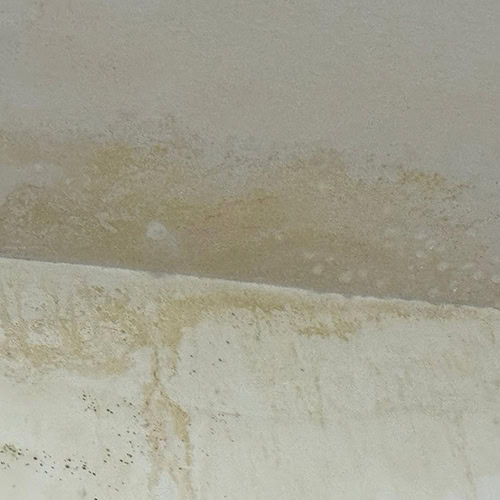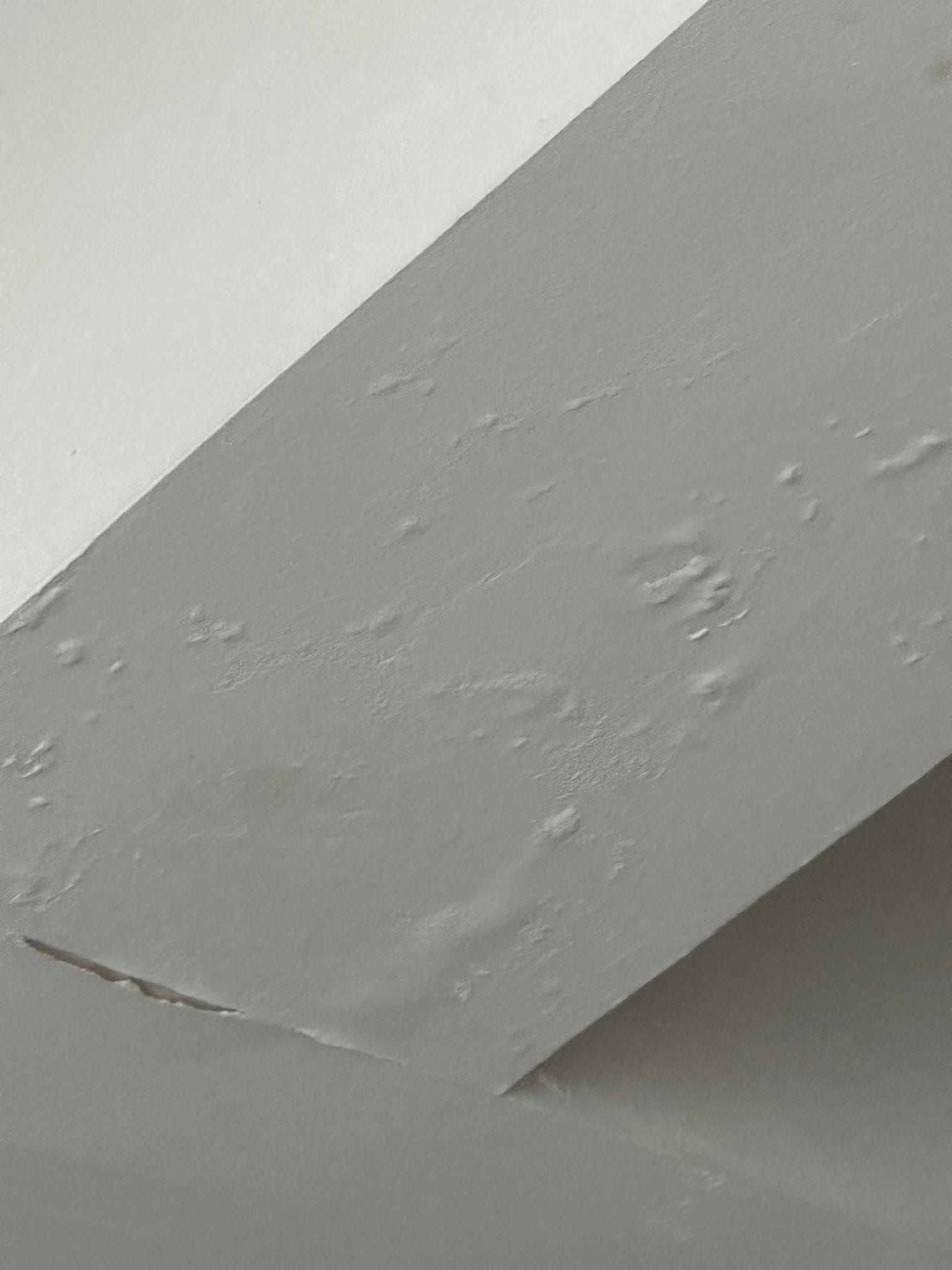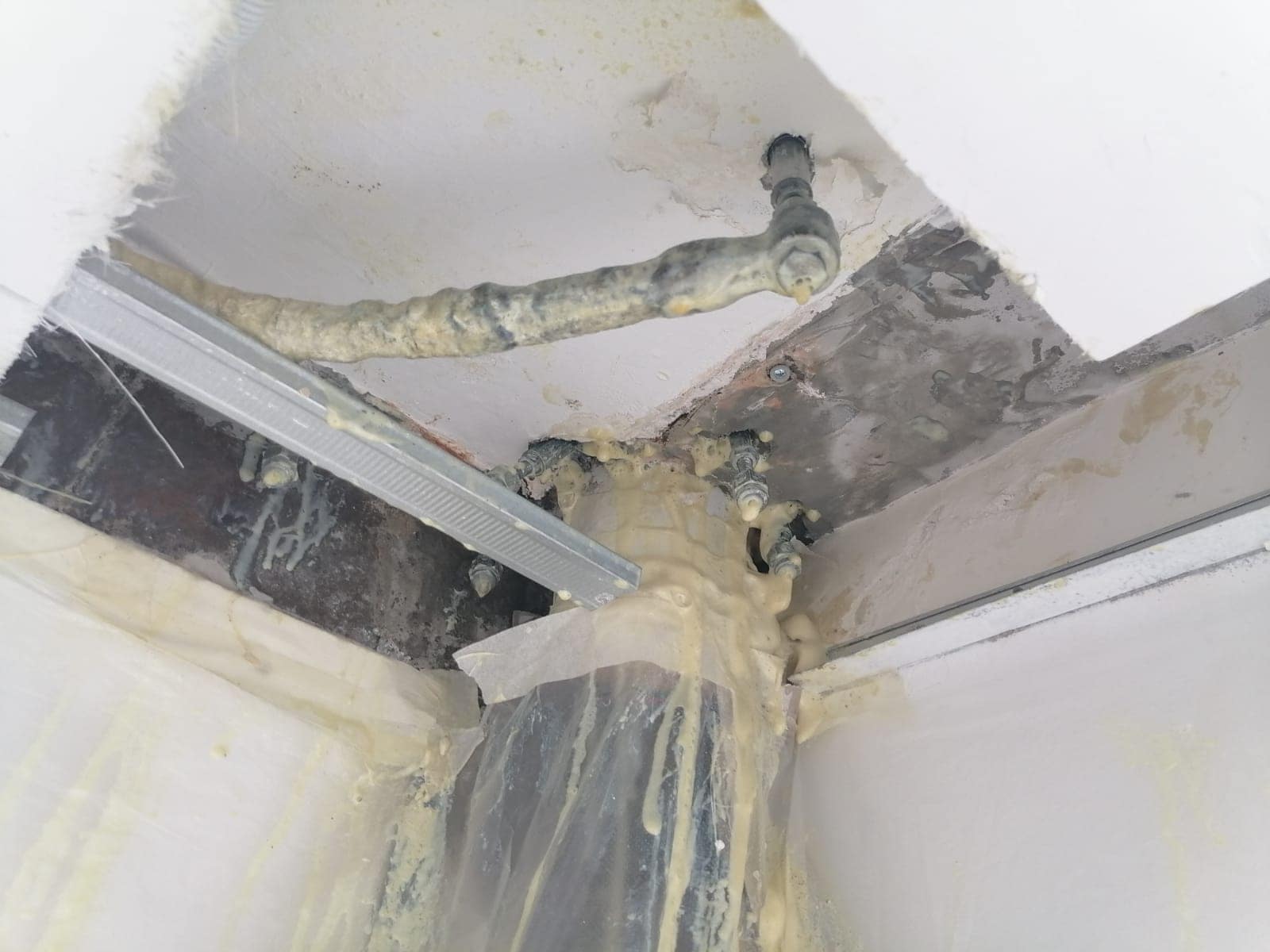Water leakage in concrete slabs is a common and often troubling issue, particularly in high-humidity environments like Singapore. If left unchecked, water leaks can cause significant structural damage, health concerns due to mold growth, and expensive repair bills.
Water leakage in concrete slabs is a serious issue that can lead to significant damage if not properly addressed. Whether caused by poor waterproofing, damaged plumbing, or environmental factors like hydrostatic pressure, water infiltration can weaken the structure, lead to mold growth, and cause costly repairs. Detecting the leak early, understanding its causes, and using the right waterproofing methods—such as PU injection grouting, waterproof membranes, or cementitious coatings—are critical steps to protect your property.
How Do I Know I Have a Leak Under My Concrete Slab?
One of the challenges of water leakage under a concrete slab is that it is not always immediately visible. Often, by the time the leak becomes noticeable, significant damage has already occurred. However, several tell-tale signs can help you detect a leak early. The first sign might be damp spots on the floor that do not dry out, even in dry weather. These damp spots indicate that water is seeping up through the concrete slab from below.
Another common indicator of a hidden leak is an unexplained spike in your water bill. If your water usage hasn’t changed but your bill has suddenly increased, this could be a sign of a leak somewhere in the system, potentially beneath the slab. Additionally, mold or mildew growth in areas where there shouldn’t be excessive moisture, such as along baseboards or lower sections of walls, can point to water seepage from beneath the floor.
Cracks in the concrete or the appearance of cold or warm spots on the floor—particularly in homes with radiant heating systems—can also signal that there is water leaking under the slab. These leaks can cause the soil to shift or settle, which in turn leads to cracks and temperature fluctuations. If you experience any of these signs, it’s important to take action immediately, as undetected leaks can lead to more severe damage over time.
Causes of Leakage in Concrete Slabs
Understanding the underlying causes of leakage in concrete slabs is essential for implementing effective waterproofing solutions. One of the most common causes is poor or inadequate waterproofing during the construction phase. If the waterproofing membrane or materials were not properly installed, water can easily seep into the concrete slab, leading to long-term issues. Another significant cause of water leakage is hydrostatic pressure. This occurs when groundwater builds up around the foundation of a building and exerts pressure on the slab. If the slab isn’t properly sealed, this water can find its way into the structure.
In many cases, especially in older buildings, deteriorating plumbing is a major culprit. Pipes that run beneath the slab can corrode or break over time, allowing water to escape and seep into the surrounding concrete. Similarly, shifting soil or foundation settlement can create cracks or gaps in the slab, making it easier for water to penetrate the structure.
Heavy rainfall and poor drainage systems can exacerbate the problem. In climates like Singapore, where heavy rains are frequent, excess water in the soil can overwhelm the slab’s defenses if the drainage system is inadequate. In these situations, waterproofing failure becomes inevitable unless proper repairs are made.
What Are the Common Signs and Symptoms of a Water Leak Under My Concrete Slab?
Water leakage under a concrete slab manifests in a variety of ways. Some symptoms are immediate and obvious, while others may develop more slowly over time. One of the earliest signs is damp or musty odors. Even if you don’t see visible water, the presence of moisture beneath the slab can create a persistent musty smell, particularly in basements or ground-floor rooms.
Another common sign is stained walls and floors. As water seeps up through the concrete, it can cause discoloration on the walls or floors near the leak. These stains may start small but can grow over time if the leak is not addressed. In some cases, you may even see water pooling on the floor or notice that flooring materials like tiles, wood, or carpet are warping, bubbling, or lifting due to the moisture.
One of the more visible signs of water leakage is efflorescence, which appears as a chalky white substance on concrete surfaces. This occurs when water that has penetrated the concrete evaporates, leaving behind mineral deposits. These symptoms, especially when combined with cracks or structural weaknesses in the slab, are clear indicators that waterproofing measures are failing.
What Happens If Water Gets Under a Concrete Slab?
The consequences of water infiltration beneath a concrete slab can be severe if left unaddressed. One of the most serious risks is structural damage. As water seeps into the slab, it can weaken the concrete over time, leading to cracks and, eventually, significant structural failures. This not only threatens the integrity of the building but can also lead to costly repairs.
Another major consequence is mold and mildew growth. The moist environment created by water under the slab is the perfect breeding ground for mold, which can spread quickly through walls and floors. This not only damages the property but can also pose serious health risks, especially for individuals with allergies or respiratory conditions.
Flooring damage is another common issue caused by water leaks. Materials like hardwood, laminate, and carpet can warp or rot when exposed to excessive moisture, requiring expensive replacement or repair. Additionally, water can cause foundation settlement. When the soil beneath the slab becomes oversaturated with water, it can shift or settle, leading to uneven floors, cracks in walls, and other structural issues. If left unattended, water under the slab can cause permanent waterproofing damage, making the structure more vulnerable to future leaks and water ingress.
How to Fix a Water Leak Under a Slab?
Repairing a water leak under a concrete slab can be challenging, but there are effective solutions available. The first step is to accurately detect the leak. Professional contractors often use specialized equipment like acoustic listening devices or infrared cameras to pinpoint the exact location of the leak without the need for extensive excavation. Once the leak has been identified, the next step is to determine the best repair method.
For minor leaks, PU injection grouting is one of the most common and effective solutions. This method involves injecting polyurethane foam into the cracks or gaps in the concrete slab. The foam expands to fill the voids, creating a watertight seal that prevents further water infiltration. PU injection grouting is minimally invasive and does not require major demolition, making it a popular choice for slab repairs.
In cases where the leak is caused by damaged plumbing, plumbing repairs may also be necessary. This typically involves replacing the damaged section of the pipe and repairing the surrounding slab. If the damage to the slab is extensive, parts of the slab may need to be repaired or replaced. This involves removing the damaged section, fixing the underlying problem, and re-pouring the concrete.
Another effective treatment is membrane waterproofing. This involves placing a waterproof membrane, over the concrete slab. The membrane acts as a protective layer, preventing water from seeping into the concrete.
Cementitious waterproofing is another option, particularly for slabs that are exposed to water. This method involves applying a cement-based waterproof coating to the surface of the slab, which creates a strong, waterproof barrier.
A professional waterproofing contractor will assess the situation and recommend the best treatment method based on the extent of the leak and the specific needs of the property.
Who Should Be Responsible for Repairing the Concrete Slab in Condos and HDB Flats?
The responsibility for repairing a leaking concrete slab can vary depending on the property type and the location of the leak. In condominiums, the management or condo association is generally responsible for repairs to common areas, which may include the concrete slab if it is part of the building’s structure. However, if the leak is caused by something within the individual unit, such as a faulty pipe or poor waterproofing, the homeowner may be responsible for the repairs.
In HDB flats, the responsibility for slab repairs typically falls under the jurisdiction of the HDB or the town council if the leak affects common areas or structural elements. However, if the leak originates from within the flat, such as a pipe under the floor, the homeowner is generally responsible for the repair costs. Homeowners need to report any leaks to the relevant authorities and seek professional waterproofing contractors to assess and repair the damage promptly.
In both condos and HDB flats, it is important to clearly understand who is responsible for the repairs to avoid unnecessary delays. For instance, if the leak originates from a common area in a condo, such as the concrete slab that forms part of the building’s foundation, it is typically the responsibility of the condo’s management committee or managing agent to coordinate and pay for the repairs. They may engage a licensed waterproofing contractor to conduct an inspection and perform the necessary repair work.
However, if the leak is localized to a private unit and is due to issues within that unit’s plumbing or waterproofing systems, the homeowner will usually need to bear the cost of the repair. To ensure that repairs are carried out effectively and in compliance with building standards, it’s crucial to hire a BCA-certified waterproofing contractor. This is especially important in Singapore, where regulations regarding waterproofing and building maintenance are stringent.
In HDB flats, the situation is similar but often more straightforward. HDB or the Town Council will typically handle structural repairs, including leaks that affect multiple units or arise from the building’s foundation. If the leak is due to an internal issue such as damaged plumbing or inadequate waterproofing within a flat, the homeowner is to arrange for repairs at their own expense. In both scenarios, identifying the correct party responsible for the repair is crucial for timely resolution.
How Is the Repair Work Carried Out?
Repairing water leakage under a concrete slab requires a structured approach to ensure the problem is thoroughly addressed. Professional waterproofing contractors will start by conducting an in-depth inspection to locate the source of the leak. This is often done using specialized equipment such as moisture detectors, infrared cameras, or acoustic listening devices. Once the leak’s source is identified, contractors will outline the most effective method for the repair.
When it comes to concrete slab waterproofing, the best method depends on the specific circumstances of the building and the type of leak. One of the most commonly recommended methods in Singapore is the use of PU injection grouting, which is ideal for sealing cracks and preventing water infiltration in concrete slabs. The expanding nature of polyurethane foam allows it to fill even the smallest gaps, creating a durable, watertight barrier.
During this process, small holes are drilled into the concrete, and polyurethane foam is injected into the cracks or voids. As the foam expands, it fills the gaps and forms a waterproof seal. This method is highly effective because it can reach even the smallest cracks, preventing future leaks. PU grouting is also a non-invasive solution, meaning there’s no need to remove large sections of the slab, which reduces both the cost and disruption of repairs.
In cases where the slab has more extensive damage, a more robust slab waterproofing solution may be necessary. This could involve applying a waterproof membrane to the entire slab to prevent water ingress. Waterproof membranes, such as bituminous membranes or PVC waterproofing, are laid over the slab surface to create a long-lasting protective barrier.
If the leak is due to damaged plumbing beneath the slab, the contractor will repair or replace the affected pipes. This might involve removing a section of the slab to access the damaged pipe, repairing or replacing it, and then re-applying the concrete.
In all cases, contractors will also ensure that any waterproofing measures used during the repair meet Singapore’s Building and Construction Authority (BCA) standards. This ensures that the building remains compliant with local regulations and that the repairs will be durable and long-lasting.
Why PU Injection Grouting Is an Effective Solution?
One of the standout methods for addressing water leaks in concrete slabs is PU injection grouting. This technique involves injecting polyurethane (PU) foam into cracks, joints, or voids in the slab, where it rapidly expands to form a tight, water-resistant seal. PU grouting is particularly effective for sealing active leaks in both new and old concrete structures.
The advantages of PU injection grouting are numerous. It is a non-invasive procedure, meaning contractors don’t need to break through the concrete slab to fix the problem. This reduces the time, cost, and disruption of the repair process. Polyurethane foam expands upon contact with moisture, and it can fill even the smallest cracks and voids, creating a reliable waterproof barrier.
PU injection grouting is also highly durable, making it suitable for areas that experience frequent water exposure or hydrostatic pressure, such as basements or areas with high groundwater levels. The foam’s expansion properties ensure a long-lasting solution, preventing further water seepage. Additionally, PU injection grouting is compatible with various types of structures and can be used in conjunction with other waterproofing systems to provide comprehensive protection.
For property owners dealing with waterproofing damage or recurring leaks, PU grouting offers an efficient and cost-effective solution that addresses the root cause of the problem without the need for extensive construction work.
In Singapore, where humidity and heavy rainfall are common, ensuring your concrete slab is properly waterproofed is essential. Engaging a BCA-certified waterproofing contractor can ensure that the repair work is carried out to the highest standards and in compliance with local building codes. Whether you are a homeowner in a condo or an HDB flat, understanding who is responsible for the repair and how the work should be conducted is crucial to resolving the issue efficiently.
By taking prompt action and choosing the right waterproofing solutions, property owners can prevent further damage, protect their investments, and ensure the long-term integrity of their buildings.
SWC Construction is a leading waterproofing contractor in Singapore, specializing in providing top-quality solutions to resolve concrete slab leakage and a wide range of waterproofing-related issues. With extensive expertise and a commitment to delivering the best results, we ensure every project is completed to the highest standard, offering long-lasting protection from water damage. Our dedication to excellence is reflected in the positive reviews from prestigious clients who consistently praise the company for its reliable service, exceptional workmanship, and successful project outcomes.
For a hassle-free waterproofing repair experience, contact us now at SWC Construction. We provide effective solutions to fix leaks and water damage efficiently. Our skilled team ensures precise repairs with long-lasting results, consistently earning praise for our seamless service and quality workmanship. Let us handle your waterproofing needs for a stress-free solution.





